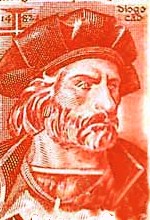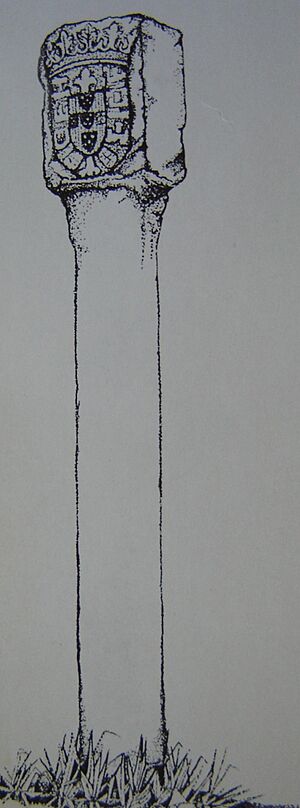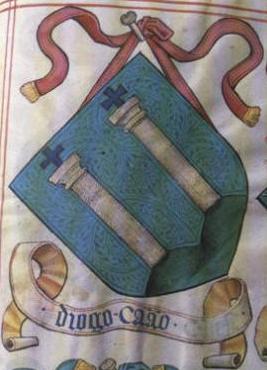Diogo Cão facts for kids
Quick facts for kids
Diogo Cão
|
|
|---|---|
 |
|
| Born | ca. 1452 Vila Real, Kingdom of Portugal
|
| Died | ca. 1486 |
| Nationality | Portuguese |
| Occupation | Navigator and explorer |
| Known for | First European to explore the Congo River and the west coast of Africa. |
Diogo Cão was a famous Portuguese explorer and sailor. He lived during the Age of Discovery, a time when Europeans explored many new parts of the world. In the 1480s, he made two important trips along the west coast of Africa. During these journeys, he explored the Congo River and the coasts of what are now Angola and Namibia.
Contents
Diogo Cão's Early Life
Diogo Cão was born in the mid-1400s in Vila Real, Portugal. His father was Álvaro Fernandes or Gonçalves Cão, who worked for the King's household. Diogo Cão later married and had four children: Pedro, Manuel, André Afonso, and Isabel.
Exploring the African Coast
Diogo Cão was the first European known to see and enter the Congo River. He also explored a large part of the West African coast. This area stretches from Cape St. Catherine in Gabon all the way to Cape Cross in Namibia. This means he explored almost from the equator down to Walvis Bay.
First Journey of Discovery
When King John II of Portugal decided to continue the explorations started by Prince Henry the Navigator, he chose Diogo Cão. Cão likely began his first voyage around mid-1482. His mission was to explore the African coast south of the equator.
Diogo Cão's ship carried special stone pillars called padrões. These pillars had a cross on top, representing the Order of Christ. They also had the Portuguese royal coat of arms carved into them. The plan was to place one of these padrões in every new place he discovered. This would show that Portugal claimed the land.
On his way, Cão stopped at the newly built Elmina Castle to get supplies. He soon discovered the mouth of the Congo River, probably in August 1482. He placed a padrão at Shark Point, marking Portugal's claim to the area. This pillar's base can still be seen today.
Cão sailed a short distance up the Congo River. He began trading with the local people of the Bakongo kingdom. He learned that their King lived further up the river. Cão sent four of his men to meet the King. He also took four local people with him to serve as ambassadors from Kongo in Portugal. Then, he sailed back down to the Atlantic Ocean.
Cão continued sailing along the coast of what is now Angola. He put up a second padrão at Cape Saint Mary. This pillar likely marked the end of his first journey. The first padrão at the Congo River's mouth was later taken by an English ship. However, the second padrão at Cape Saint Mary still stands today, though its cross is gone.
Diogo Cão returned to Lisbon by April 8, 1484. King John II was very pleased with his discoveries. The King made him a knight of his royal household. He also gave Cão a yearly payment and a special coat of arms. This coat of arms even showed two padrões on it. The King then asked Cão to return to Kongo to bring back the four men he had left there.
Second Journey of Discovery
Diogo Cão began his second voyage between 1484 and 1486. It is unlikely that Martin Behaim joined him, despite some claims. However, we know that Cão revisited the Congo River. He placed two more padrões even further south than his last trip. The first was at Cabo Negro in Angola, and the second was at Cape Cross. The Cape Cross pillar probably marked the furthest point south he reached, about 1,400 kilometers from his previous stop. Diogo Cão also picked up the four local ambassadors he had promised to return.
Cão sailed up the Kongo River, thinking it might lead to the legendary kingdom of Prester John. He reached the area near Matadi. There, in October or November 1485, close to the Ielala Falls, he carved an inscription into a stone. This carving shows that he and his men were there. It reads: Aqui chegaram os navios do esclarecido rei D.João II de Portugal - Diogo Cão, Pero Anes, Pero da Costa. This means: "Here reached the ships of the enlightened king John II of Portugal – Diogo Cão, Pero Anes, Pero da Costa."
Some historical accounts say Cão died off Cape Cross. However, other sources suggest he returned to Kongo and then brought a native envoy back to Portugal. A report from 1525 stated he died near Serra Parda. A map from 1489 also shows a padrão near Serra Parda with the words "and here he died."
All four padrões that Cão set up on his two voyages have been found. The inscriptions on two of them, from Cape Santa Maria and Cape Cross, are still readable. The Cape Cross padrão was in Berlin for a long time but was recently returned to Namibia. The others are in the Museum of the Lisbon Geographical Society.
Honoring Diogo Cão
Many years after his death, people continued to honor Diogo Cão. In Vila Real, his hometown, a plaza was named after him. In the center of this plaza stands a bronze statue of him.
In 1999, André Roubertou, a French expert, named an undersea hole after him. This hole is located off the southern coast of Portugal in the Gulf of Cádiz. It is now called the Diogo Cão Hole.
In 2018, a large ship called a hopper dredger was launched. This ship, which helps clear waterways, was named the Diogo Cao.
Diogo Cão in Books
Diogo Cão is the main topic of "Padrão," a famous poem by Fernando Pessoa. This poem is part of his book Mensagem. Cão also plays a big role in the 1996 novel Lord of the Kongo by Peter Forbath.
Images for kids
See also
 In Spanish: Diogo Cão para niños
In Spanish: Diogo Cão para niños









